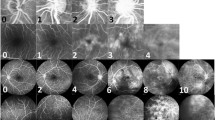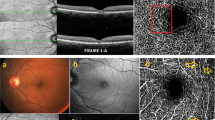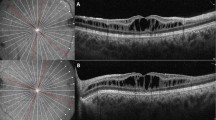Abstract
Purpose
To evaluate the prevalence of cystic macular lesions in patients with Usher II syndrome.
Methods
All Usher type II patients seen in the inherited eye disease clinic at the University of Illinois at Chicago between January 2002 and December 2007 were included (n=76). Each participating patient underwent a detailed clinical examination, including best-corrected visual acuity, slit-lamp biomicroscopy and dilated fundus examination. The presence of cystoid lesions was determined by optical coherence tomography (OCT), fundus fluorescein angiogram (FFA), fundus photographs and/or clinical examination.
Results
A cystic-appearing macular change was observed in at least one eye in 19 out of the 76 patients (25%), 13 on the basis of OCT, five using FFA (two solely with the use of FFA and three based on clinical notes and FFA findings) and one based solely on clinical notes. Of the 18 patients with CME, determined by OCT or FFA, five (27.8%) showed either a funduscopically normal-appearing macula (n=4) or an atrophic appearing macular change (n=1).
Conclusions
One-fourth of our total cohort of Usher II patients had cystic macular lesions. Moreover, a funduscopically normal-appearing macula was observed in 22% (n=4) of our 18 patients with cystic-appearing macular lesions on OCT and/or FFA testing. On the basis of the reasonably high prevalence of cystic macular lesions in our cohort, it would seem prudent to evaluate Usher II patients for the presence of cystoid macular oedema.
Similar content being viewed by others
Log in or create a free account to read this content
Gain free access to this article, as well as selected content from this journal and more on nature.com
or
References
Fishman GA, Kumar A, Joseph ME, Torok N, Anderson RJ . Usher's syndrome. Ophthalmic and neuro-otologic findings suggesting genetic heterogeneity. Arch Ophthalmol 1983; 101: 1367–1374.
Hope CI, Bundey S, Proops D, Fielder AR . Usher syndrome in the city of Birmingham—prevalence and clinical classification. Br J Ophthalmol 1997; 81: 46–53.
Rosenberg T, Haim M, Hauch AM, Parving A . The prevalence of Usher syndrome and other retinal dystrophy-hearing impairment associations. Clin Genet 1997; 51: 314–321.
Kremer H, van Wijk E, Märker T, Wolfrum U, Roepman R . Usher syndrome: molecular links of pathogenesis, proteins and pathways. Hum Mol Genet 2006; 15 Spec No 2: R262–R270.
Smith RJ, Berlin CI, Hejtmancik JF, Keats BJ, Kimberling WJ, Lewis RA et al. Clinical diagnosis of the Usher syndromes. Usher Syndrome Consortium. Am J Med Genet 1994; 50: 32–38.
Tsilou ET, Rubin BI, Caruso RC, Reed GF, Pikus A, Hejtmancik JF et al. Usher syndrome clinical types I and II: could ocular symptoms and signs differentiate between the two types? Acta Ophthalmol Scand 2002; 80: 196–201.
Piazza L, Fishman GA, Farber M, Anderson RJ . Visual acuity loss in patients with Usher's syndrome. Arch Ophthalmol 1986; 104: 1336–1339.
Fishman GA, Anderson RJ, Lam BL, Derlacki DJ . Prevalence of foveal lesions in type 1 and type 2 Usher's syndrome. Arch Ophthalmol 1995; 113: 770–773.
Stanga PE, Downes SM, Ahuja RM, Chong NH, Antcliff R, Reck AC et al. Comparison of optical coherence tomography and fluorescein angiography in assessing macular edema in retinal dystrophies: preliminary results. Int Ophthalmol 2001; 23: 321–325.
Hee MR, Puliafito CA, Wong C, Duker JS, Reichel E, Schuman JS et al. Optical coherence tomography of macular holes. Ophthalmology 1995; 102: 748–756.
Hirakawa H, Iijima H, Gohdo T, Tsukahara S . Optical coherence tomography of cystoid macular edema associated with retinitis pigmentosa. Am J Ophthalmol 1999; 128: 185–191.
Apushkin MA, Fishman GA, Janowicz MJ . Monitoring cystoid macular edema by optical coherence tomography in patients with retinitis pigmentosa. Ophthalmology 2004; 111: 1899–1904.
Chung H, Hwang JU, Kim JG, Yoon YH . Optical coherence tomography in the diagnosis and monitoring of cystoid macular edema in patients with retinitis pigmentosa. Retina 2006; 26: 922–927.
Haouchine B, Massin P, Gaudric A . Foveal pseudocyst as the first step in macular hole formation: a prospective study by optical coherence tomography. Ophthalmology 2001; 108: 15–22.
Ghoraba H . Types of macular holes encountered during diabetic vitrectomy. Retina 2002; 22: 176–182.
Moldow B, Sander B, Larsen M, Engler C, Li B, Rosenberg T et al. The effect of acetazolamide on passive and active transport of fluorescein across the blood-retina barrier in retinitis pigmentosa complicated by macular oedema. Graefes Arch Clin Exp Ophthalmol 1998; 236: 881–889.
Giusti C, Forte R, Vingolo EM . Deflazacort treatment of cystoid macular edema in patients affected by Retinitis Pigmentosa: a pilot study. Eur Rev Med Pharmacol Sci 2002; 6: 1–8.
García-Arumí J, Martinez V, Sararols L, Corcostegui B . Vitreoretinal surgery for cystoid macular edema associated with retinitis pigmentosa. Ophthalmology 2003; 110: 1164–1169.
Fishman GA, Gilbert LD, Fiscella RG, Kimura AE, Jampol LM . Acetazolamide for treatment of chronic macular edema in retinitis pigmentosa. Arch Ophthalmol 1989; 107: 1445–1452.
Newsome DA, Blacharski PA . Grid photocoagulation for macular edema in patients with retinitis pigmentosa. Am J Ophthalmol 1987; 103: 161–166.
Ozdemir H, Karacorlu M, Karacorlu S . Intravitreal triamcinolone acetonide for treatment of cystoid macular oedema in patients with retinitis pigmentosa. Acta Ophthalmol Scand 2005; 83: 248–251.
Grover S, Apushkin MA, Fishman GA . Topical dorzolamide for the treatment of cystoid macular edema in patients with retinitis pigmentosa. Am J Ophthalmol 2006; 141: 850–858.
Scorolli L, Morara M, Meduri A, Reggiani LB, Ferreri G, Scalinci SZ et al. Treatment of cystoid macular edema in retinitis pigmentosa with intravitreal triamcinolone. Arch Ophthalmol 2007; 125: 759–764.
Fishman GA, Cunha-Vaz J, Salzano T . Vitreous fluorophotometry in patients with retinitis pigmentosa. Arch Ophthalmol 1981; 99: 1202–1207.
Mallick KS, Zeimer RC, Fishman GA, Blair NP, Anderson RJ . Transport of fluorescein in the ocular posterior segment in retinitis pigmentosa. Arch Ophthalmol 1984; 102: 691–696.
Heckenlively JR, Jordan BL, Aptsiauri N . Association of antiretinal antibodies and cystoid macular edema in patients with retinitis pigmentosa. Am J Ophthalmol 1999; 127: 565–573.
Schwartz SB, Aleman TS, Cideciyan AV, Windsor EA, Sumaroka A, Roman AJ et al. Disease expression in Usher syndrome caused by VLGR1 gene mutation (USH2C) and comparison with USH2A phenotype. Invest Ophthalmol Vis Sci 2005; 46: 734–743.
Jackson H, Garway-Heath D, Rosen P, Bird AC, Tuft SJ . Outcome of cataract surgery in patients with retinitis pigmentosa. Br J Ophthalmol 2001; 85: 936–938.
Acknowledgements
Supported by funds from the Foundation Fighting Blindness, Owings Mills Maryland, USA; the Grant Healthcare Foundation, Lake Forest, Illinois; NIH core Grant YO 1792 and an unrestricted departmental grant from Research to Prevent Blindness.
Author information
Authors and Affiliations
Corresponding author
Additional information
The authors do not have any proprietary interest in this work.
Rights and permissions
About this article
Cite this article
Walia, S., Fishman, G. & Hajali, M. Prevalence of cystic macular lesions in patients with Usher II syndrome. Eye 23, 1206–1209 (2009). https://doi.org/10.1038/eye.2008.105
Received:
Revised:
Accepted:
Published:
Issue date:
DOI: https://doi.org/10.1038/eye.2008.105
Keywords
This article is cited by
-
Retinal findings in pediatric patients with Usher syndrome Type 1 due to mutations in MYO7A gene
Eye (2020)
-
Biomarkers in Usher syndrome: ultra-widefield fundus autofluorescence and optical coherence tomography findings and their correlation with visual acuity and electrophysiology findings
Documenta Ophthalmologica (2020)
-
Novel grading system for quantification of cystic macular lesions in Usher syndrome
Orphanet Journal of Rare Diseases (2015)
-
Werner syndrome with refractory cystoid macular edema and immunohistochemical analysis of WRN proteins in human retinas
BMC Ophthalmology (2014)
-
Pharmakologische Ansätze in der Therapie erblicher Netzhautdegenerationen
Der Ophthalmologe (2012)



